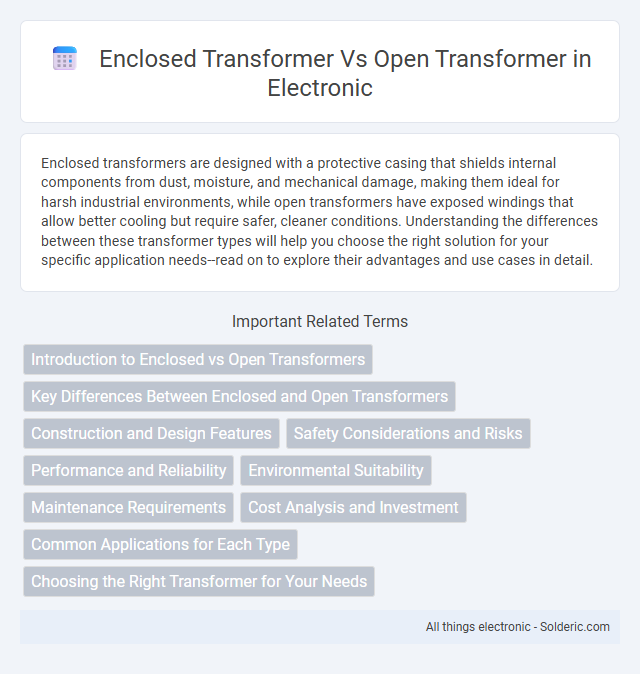Enclosed transformers are designed with a protective casing that shields internal components from dust, moisture, and mechanical damage, making them ideal for harsh industrial environments, while open transformers have exposed windings that allow better cooling but require safer, cleaner conditions. Understanding the differences between these transformer types will help you choose the right solution for your specific application needs--read on to explore their advantages and use cases in detail.
Comparison Table
| Feature | Enclosed Transformer | Open Transformer |
|---|---|---|
| Protection | Fully enclosed in metal casing; protects internal components from dust, moisture, and physical damage. | Exposed internal parts; prone to environmental contamination and mechanical damage. |
| Cooling | Built-in cooling system; often oil-filled for efficient heat dissipation. | Relies on natural air cooling; less effective in hot or dusty environments. |
| Maintenance | Lower maintenance due to sealed design; less frequent inspections needed. | Higher maintenance; frequent cleaning and inspections required. |
| Application | Suitable for harsh and outdoor environments. | Used mainly indoors or controlled environments. |
| Cost | Generally higher initial cost due to enclosure and insulation materials. | Lower initial cost, simpler design. |
| Durability | High durability and long service life under tough conditions. | Lower durability; sensitive to contaminants and mechanical impacts. |
Introduction to Enclosed vs Open Transformers
Enclosed transformers feature protective casings that shield internal components from environmental factors such as dust, moisture, and physical damage, enhancing durability and safety in outdoor or harsh conditions. Open transformers lack this protective enclosure, allowing for better cooling but requiring controlled environments to prevent exposure-related failures. Selecting between enclosed and open transformers depends on application-specific requirements for protection, cooling efficiency, and installation environment.
Key Differences Between Enclosed and Open Transformers
Enclosed transformers feature a protective casing that shields internal components from dust, moisture, and physical damage, enhancing durability and safety in harsh environments. Open transformers lack this protective enclosure, allowing better cooling through natural air circulation but exposing windings and core to environmental contaminants. The trade-off between protection and cooling efficiency defines their application suitability in industrial, commercial, or residential settings.
Construction and Design Features
Enclosed transformers feature protective casings that shield internal components from dust, moisture, and mechanical damage, enhancing durability and safety in harsh environments. Open transformers have exposed windings and core, allowing efficient heat dissipation but requiring controlled surroundings to prevent contamination and damage. Your choice depends on installation conditions; enclosed transformers suit outdoor or industrial settings, while open transformers fit clean, ventilated indoor spaces.
Safety Considerations and Risks
Enclosed transformers offer enhanced safety by protecting internal components from external contaminants, reducing the risk of electrical shock, fire, and mechanical damage. Open transformers expose live parts, increasing hazards such as accidental contact and environmental exposure, which can lead to overheating or short circuits. Choosing an enclosed transformer ensures better protection for your equipment and personnel, especially in environments with dust, moisture, or potential physical impact.
Performance and Reliability
Enclosed transformers offer superior protection against dust, moisture, and environmental contaminants, leading to enhanced reliability and longer operational lifespan compared to open transformers. Their sealed design reduces the risk of electrical faults and mechanical damage, ensuring consistent performance in harsh conditions. Choosing an enclosed transformer improves your system's durability and minimizes maintenance needs in challenging environments.
Environmental Suitability
Enclosed transformers offer superior protection against environmental factors such as dust, moisture, and corrosive elements, making them ideal for harsh or outdoor conditions. Open transformers, lacking protective enclosures, are better suited for clean, controlled indoor environments with minimal exposure to contaminants. Selecting the appropriate transformer depends heavily on the operating environment's exposure to pollutants and weather conditions to ensure longevity and reliable performance.
Maintenance Requirements
Enclosed transformers require less frequent maintenance due to their protective casing, which shields internal components from dust, moisture, and contaminants, extending their operational lifespan. Open transformers expose windings and core to the environment, necessitating regular inspections, cleaning, and testing to prevent corrosion and electrical faults. Maintenance tasks for enclosed transformers typically include periodic oil testing and monitoring, whereas open transformers demand more intensive care to ensure reliability and safety.
Cost Analysis and Investment
Enclosed transformers typically require higher initial investment due to their robust protective casings, which shield internal components from environmental factors, reducing maintenance costs over time. Open transformers, while more affordable upfront, often incur increased expenses related to repairs, replacements, and downtime caused by exposure to dust, moisture, and physical damage. Your choice between enclosed and open transformers should weigh the balance between upfront capital expenditure and long-term operational costs to optimize investment returns.
Common Applications for Each Type
Enclosed transformers are commonly used in industrial equipment, outdoor power systems, and hazardous environments where protection from dust, moisture, and physical damage is critical. Open transformers are typically found in indoor applications such as control panels, electronic devices, and laboratory equipment where ventilation is necessary for heat dissipation. Both types are selected based on environmental conditions and specific operational requirements.
Choosing the Right Transformer for Your Needs
Enclosed transformers provide superior protection against dust, moisture, and contaminants, making them ideal for harsh or outdoor environments, while open transformers offer better heat dissipation and are typically used in clean, controlled indoor settings. Selecting the right transformer depends on environmental factors, ventilation requirements, and maintenance accessibility. Assessing these conditions ensures optimal performance, longevity, and safety for your electrical systems.
enclosed transformer vs open transformer Infographic

 solderic.com
solderic.com